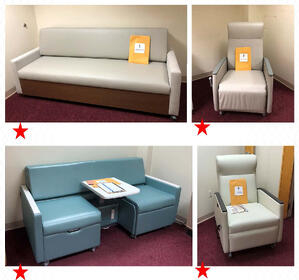

Many people find it difficult to choose furniture for their home. Often this task requires several trips to various furniture stores to understand what options are available and how much they cost. Throw in the opinion of a significant other and choosing a piece of furniture can quickly become a daunting task. Imagine going through that process for an entire hospital, with a multitude of stakeholders who have different objectives and their own personal style preferences. At Array, we help our clients use data to reach consensus, transforming traditionally-subjective topics – like furniture selection – into more value-based, objective decisions.
During the design development process, the interior design team begins focusing on the furniture selection criteria across a broad project scope. Performance metrics and aesthetic criteria will vary by zone. Public lobbies and dining zones have very different demands than a bustling emergency department; task seating criteria in a 24/7 nurse station is different from administrative zones with assigned workstations. Patient rooms must meet nursing demands and exceed patient and family expectations.
When Array led the furniture selection and specification process at Inspira Health Network for their greenfield hospital, interior designers set up a selection of pieces for each use case that aligned with the following evaluation metrics:
- Appropriateness
- Patient safety
- Infection control
- Aesthetic
- First cost vs. lifecycle costs
- Budget
- Performance
- Comfort
- Compatibility with building design
- Durability / maintainability / cleanability
- Sustainability
- Warranty
Under the guidance of our team, stakeholders from a variety of disciplines tested and reviewed the curated furniture options. Rather than collect anecdotal comments and qualitative opinions, Array used data collected during the furniture fair to help Inspira understand the pros and cons of each piece in alignment with pre-established metrics. Attendees completed an evaluation sheet for each furniture item reviewed. The customized forms had multiple criteria, eliminating some of the bias that can emerge when a simple comment or single-rating score is used.
After collecting the responses, the interior designers worked with Array’s healthcare systems engineer to analyze and visualize the data. The resultant objective data gave the multidisciplinary teams of clinicians, facilities, EVS, and therapists the confidence that their voices were heard and their expertise was valued. Presented with the dashboard-style scorecards, which synthesized the collected data, project leaders were given the confidence to move forward with purchasing decisions.
Stakeholder engagement is a common client goal. When collecting feedback for a content area as broad as furniture selection, where personal taste is subjective and even a basic knowledge of performance criteria can have great variation, it is imperative that the design team provide metric-based structure and scoring criteria that will lead to selections that meet and exceed aesthetic, ergonomic, safety and lifecycle goals.
Interested in learning more about how data-driven decision making can enhance your capital project? Read about the journey we took with West Chester Gastroenterology determining how to best utilize their space by clicking below.

